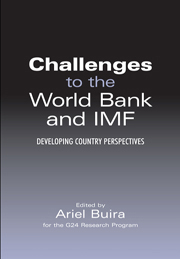Book contents
- Frontmatter
- Contents
- Contributors to this volume
- Foreword
- Introduction
- 1 The Governance of the IMF in a Global Economy
- 2 Who pays for the IMF?
- 3 An Analysis of IMF Conditionality
- 4 Achieving Long-Term Debt Sustainability in Heavily Indebted Poor Countries (HIPCs)
- 5 The Poverty Reduction Strategy Paper Approach: Good Marketing or Good Policy?
- 6 Capital Management Techniques in Developing Countries
- 7 International Reserves to Short-Term External Debt as an Indicator of External Vulnerability: The Experience of Mexico and Other Emerging Economies
- 8 Mechanisms for Dialogue and Debt-Crisis Workout that Can Strengthen Sovereign Lending to Developing Countries
- 9 Developing a Global Partnership for Development
- 10 International Financial Institutions and International Public Goods: Operational Implications for the World Bank
- Index
3 - An Analysis of IMF Conditionality
- Frontmatter
- Contents
- Contributors to this volume
- Foreword
- Introduction
- 1 The Governance of the IMF in a Global Economy
- 2 Who pays for the IMF?
- 3 An Analysis of IMF Conditionality
- 4 Achieving Long-Term Debt Sustainability in Heavily Indebted Poor Countries (HIPCs)
- 5 The Poverty Reduction Strategy Paper Approach: Good Marketing or Good Policy?
- 6 Capital Management Techniques in Developing Countries
- 7 International Reserves to Short-Term External Debt as an Indicator of External Vulnerability: The Experience of Mexico and Other Emerging Economies
- 8 Mechanisms for Dialogue and Debt-Crisis Workout that Can Strengthen Sovereign Lending to Developing Countries
- 9 Developing a Global Partnership for Development
- 10 International Financial Institutions and International Public Goods: Operational Implications for the World Bank
- Index
Summary
Institutions are not … created to be socially efficient; rather they, or at least the formal rules, are created to serve the interests of those with the bargaining power to create new rules.
Douglas C North Nobel Lecture, 1993Abstract
What is the nature and purpose of IMF conditionality, and is it required to safeguard Fund resources? This chapter reviews these issues and then poses some key questions. For example, can program ownership by a country be made compatible with externally imposed conditionality? To what extent is conditionality of the international financial institutions (IFIs) power without responsibility? What, if any, are the consequences for the IMF of imposing programs that fail more often than not? It looks into the reasons for increased conditionality during the 1980s and 1990s and reviews the recent debate on conditionality. As the number of conditions – in particular structural ones – grew rapidly during the 1980s and the 1990s, the rate of compliance with IMF-supported programs saw a parallel and sharp decline. The chapter also presents an analysis that distinguishes between different types of external crises: short-term imbalances that result from excess demand and expansionary policies; mediumterm structural disequilibria such as those resulting from time lags in production (future supply) from investment spending (current demand); and currency and external crises resulting from sudden reversals of capital flows, noting that different types of underlying causes of imbal-ances call for different sets of policy conditionality.
- Type
- Chapter
- Information
- Challenges to the World Bank and IMFDeveloping Country Perspectives, pp. 55 - 90Publisher: Anthem PressPrint publication year: 2003
- 14
- Cited by

